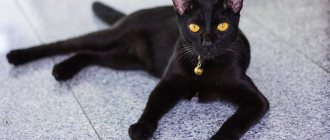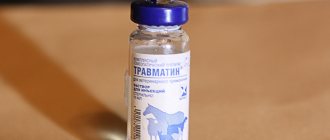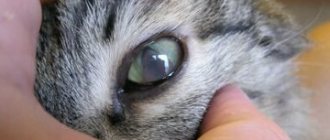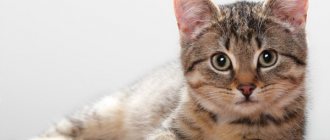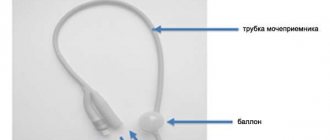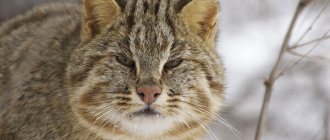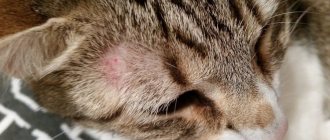How to determine a cat's age by its teeth
An animal’s teeth are one of the surest indicators of a pet’s health and the number of years it will live. It is the condition of the teeth that will help you find out how to determine the age of the cat, and not just the baby.
Many breeders are pleased with the versatility and simplicity of this method. The jaws of all cat breeds are designed almost the same. In rare cases, serious discrepancies in dental development are observed.
The easiest way to determine the age of kittens is because their jaws are just beginning to form:
- the first incisors appear at 2-4 weeks of the baby’s life;
- milk fangs – at 3-4 weeks;
- premolars appear at 3-8 weeks;
- first molars – for 5-12 weeks;
- At 2 months, the kitten acquires a full set of 26 teeth.
Already by 3-4 months, the first teeth will begin to change to molars. It is recommended to purchase special toys for your pet that can be chewed. Permanent teeth erupt:
- incisors – by 3-5 months;
- fangs - by 4-5 months;
- premolars – at 4-6 months;
- molars - at 4-7 months.
With kids everything is quite simple. There is minor debate among felinologists about how to determine the age of a cat by its teeth. Many people advise sticking to the following “schedule”:
- by the age of one year all teeth are white and strong;
- at one and a half years a barely noticeable yellowness appears;
- 2 years – the beginning of erasing of the incisors in the center;
- 2.5-3 years – formation of the first dental stones;
- 3-4.5 years – beginning of grinding of the upper and middle incisors;
- 5 years – erasing of fangs;
- 6-8 years – beginning of wear of the rear incisors;
- by the age of 10 – the lower incisors are greatly worn down;
- 11-14 years – loss of incisors;
- 15-16 years – loss of fangs.
Important! When answering the question of how to find out the age of a cat, it is worth considering that the condition of the teeth depends on nutrition, injuries received and diseases suffered. To be sure, you can contact a veterinarian, who can examine the condition of the enamel, gums, and tartar to be sure.
Visual inspection
In very small kittens, it is quite easy to determine their age using the following parameters:
- Umbilical cord. If it is still present in the form of a dry “tail”, then the baby is not even a week old. And in the case when there is a fresh pink mark on the abdomen, this means that it has recently fallen off. The pet's age is from one to two weeks.
- Body type. Until the first month of life, the kitten's head is disproportionate to its body and seems disproportionately large. The ears, on the contrary, are small and pressed to the skull (up to two weeks). The legs are short and weak. By two months, the body lengthens, the ears rise and become the right size.
- Eyes. In all newborns, the color of the iris is cloudy and has a blue tint. But at one and a half months he begins to match the color.
- Behavior. Until one month old, the kitten practically does not know how to walk on its own, it only crawls. The paw muscles are not yet sufficiently developed.
Older kittens can be distinguished by age by other characteristics.
Vibrissae
One of the most important tools for orienting a cat in space. In kittens up to two, three, and sometimes four months old, the whiskers are often bitten off, as if broken. This is usually done by the mother to limit the kitten's movement area and protect it from harm.
A five-month-old kitten's whiskers are usually already long and thick and match the color of the whisker pads.
After the age of seven, the mustache may lose pigmentation. By the age of nine, all pets usually have gray hair.
The easiest way to determine the approximate age of a kitten is by its teeth.
All babies are born with bare gums; the first primary incisors begin to appear in the second week of life and are fully visible by four. Canines form at three to four weeks, and premolars at six to eight weeks. Before replacement, 26 baby teeth grow.
Kittens begin to change their teeth to permanent ones at three to five months. First, the first and second incisors are renewed, then the premolars. A little later, molars grow.
At five to six months the fangs begin to process - the milk teeth fall out and the permanent ones grow in. Usually the complete change of teeth ends by seven to nine months. But, depending on the individual characteristics of the baby, this may be a different age - plus or minus two months.
Males usually finish changing their teeth a little earlier than females.
An adult animal has 30 permanent teeth, of which 6 are upper and lower incisors, 2 upper and 2 lower canines, 10 premolars and 4 molars.
In adult animals, teeth gradually begin to wear down, but although veterinarians have certain comparative standards, this process is quite individual and depends on the pet’s lifestyle.
For example, according to doctors, the incisors become completely oval-shaped by the age of ten, but in some cats this can happen by the age of five.
It is believed that the first and second incisors fall out by the age of 12 of an animal’s life, and all of them by 16. But older pets are known that have safely retained all their teeth.
Eyes
Experts note that eye color changes in all cat species during the life cycle.
By two weeks, they open in all newborns, regardless of species and breed. The change in the bluish tint of the iris begins after two weeks of life - to yellow, copper, amber, orange or any shades of green. The process is usually completed by three to six months.
Young animals usually have bright eyes; they fade with age.
It should be remembered that there are breeds in which the color of the iris never changes, and it is only blue:
- Siamese;
- Neva Masquerade;
- Balinese;
- Polynesian;
- All snow colors of all varieties.
Weight and dimensions
If the pet is healthy, then the size of its body will most likely help determine its age. Although in some individuals growth occurs slowly due to the individual characteristics of the organism.
The newborn is usually no longer than 12 cm (excluding tail). By the end of the first month of life - 15 cm, by three - about 20.
By the eyes
Eyes are not only the mirror of the soul, but also an important indicator of a pet’s age. How to find out the age of a cat at home using this criterion? It is enough to observe the behavior of the animal a little. Young cats have a lively gaze, quickly moving to an interesting object, and a little mischievous. At advanced age, these properties usually become dull.
It is worth paying attention to the structure of your pet's eyes. In a young animal, the glassy substance is smooth, without inclusions, and transparent. The iris is of even color and regular shape. In old cats, over time, the eye becomes cloudy and dull, and separation or destruction of the vitreous substance appears. The iris, which usually becomes deformed and thinner, has streaks and spots.
Important! Discharge from the eyes, clouding of the cornea, or spots on the iris may be a sign of an infectious disease or organ injury. At the first symptoms, contact your veterinarian.
Pets at a very advanced age develop wrinkles (folds) around the eyes. Discharge (watery or purulent) often forms from the lacrimal sacs.
By wool
One of the solutions to the question “how to determine the age of a cat at home” is to assess the condition of the pet’s fur. However, this method is quite subjective and depends on the breed and the surrounding climate.
Young animals have a soft, uniform, silky and durable coat. With age, the coat thins and becomes dull. Old cats develop gray hairs.
HOW OLD IS A CAT BY HUMAN STANDARDS?
The average lifespan of cats is 13-15 years. However, many of us are interested in how old a cat is by human standards. There is no standard formula for determining the ratio of the age of a person and a cat, but there are approximate data that allow us to answer this question.
So, the age of a cat “increases” in inverse proportion to the age of a person. But it is also important not to forget that the lifespan of a cat depends on the conditions of its keeping and on its belonging to a particular breed.
- - cat 1 year old - human 15 years old
- - cat is 2 years old - human is 23 years old
- - cat is 3 years old - human is 27 years old
- - cat is 4 years old - human is 32 years old
- - cat 5 years old - human 35 years old
etc.
The oldest cat can be probably 23-25 years old. This age corresponds to 100 years in humans.
By weight
Be sure to pay attention to your pet's weight! Over the years, the animal’s daily routine changes, which is why the body weight of cats of different ages is different.
Kittens move a lot, their skeleton is not yet fully formed and strong, and the fat layer is almost not deposited. This is why babies and young pets weigh quite little.
Important! Monitor your pet's diet. A poor diet or lack of adequate exercise can lead to unhealthy weight gain!
Adults, and especially older pets, are already reluctant to agree to conquer the heights of a home closet or excitingly climb expensive curtains. They tend not to play as much and prefer to take more naps. A sedentary lifestyle leads to weight gain.
HOW MANY YEARS DO DOMESTIC CATS LIVE?
The lifespan of domestic cats depends on many factors.
Firstly, it belongs to a certain breed. For example, representatives of less “elite” breeds are longer-livers than their “aristocratic” counterparts.
Secondly, their sexual activity plays a huge role in the lifespan of domestic cats. If a domestic cat (cat) does not have the opportunity to have an active sex life, then the excess of their unrealized hormones has a negative impact on their lifespan.
- The third factor is heredity.
- The fourth factor is lifestyle.
- The fifth factor is diet.
- The sixth factor is the emotional state of the animal.
- The seventh factor is the level of disease resistance.
Considering all the above factors, it is not entirely correct to talk about the life expectancy of domestic cats. Theoretically, a healthy cat under ideal conditions can live up to 25 years, but this is more the exception than the rule.
By behavior
It is possible to determine the age of a pet by its behavior. This method is quite subjective and depends on the character of the animal, but there are still common features in habits.
Baby kittens spend almost all their free time playing and communicating with each other and people. They are even ready to courageously sacrifice minutes of sleep for the sake of fun! Some kids even insistently demand attention to themselves.
Important! You should not be strict with your pet's behavior. Animals also have different types of personalities, so some cats are sociable, while others are shy.
Mature pets will enjoy spending time hunting and playing. However, they tend to be very sleepy.
Older cats no longer like unnecessary fuss, preferring quiet rest to noisy games. Pets can often be found dozing peacefully on a chair or on your bed. As cats age, their hearing often becomes dull and their vision begins to decline, which can cause the animal to become a little more fearful or nervous.
Determining the age of kittens
In kittens under 2 months of age, it is difficult to determine their age based on the condition of their teeth, fur and claws. Therefore, the owners observe their behavior and some external signs.
From 0 to 12 days
At this age, the baby is guided by smell. He feeds only on mother's milk and reacts actively to it. If the mother is not around, the babies must be bottle-fed with a special formula for newborns. When there are several kittens, they gather in a “huddle” to keep warm.
INTERESTING TO KNOW: Cat claw covers: good or bad
At this moment of development, the animals have a very awkward physique. The head is large compared to the body and has a wide mouth. The body is weak. At this time, the eyes are closed and the ears are pressed to the head. The defining criterion is the complete absence of teeth in the mouth.
From 12 days to 2 weeks
The kittens are slowly starting to look at the world. They already hear and slowly get up. The babies crawl little by little, helping themselves with their hind legs. Sometimes animals develop strabismus during this period.
Such animals no longer need regular heating with maternal warmth. Their body temperature gradually normalizes. In addition, growth of baby teeth is observed.
2 to 4 weeks
By this time, kittens are gaining weight, it is about 250 grams. Their fangs begin to grow. The eyes are already opening fully, a mischievous sparkle appears. Eye color is still quite difficult to determine.
The animals begin to move and try to jump little by little. At this point, the owner can introduce the first complementary foods. Kittens become playful and pester each other and their mother.
4 to 5 weeks
At this time, the babies are already running briskly and eating food soaked in water. They can be trained to go to the toilet in a specially designated place. The animals develop proper coordination of movements, they no longer stagger when walking as before. At this age, the mother can slowly wean the kittens off milk.
5 to 7 weeks
The eyes take on a color that matches the breed. The bite is formed, as well as the muscles. Kittens play actively: with their mother and surrounding objects. They try the food, use the litter box and explore the apartment in which they live.
During this time interval, the owner should take care of preparing the correct diet for the animal.
2 months or more
The animal acquires traits characteristic of the breed. Kittens can exist without a mother and take food. They exhibit “adult” behavior and can fawn over people.
By body processes
Perhaps determining age by the internal processes of the body is the most accurate way. Using this watch it is easy to find out how old your pet is.
Puberty in cats begins at 7-9 months (sometimes earlier, at 6 months), but in boys a little later - at 9-11 months. Slight differences may occur due to climate, breed and weight of the animal.
Determining the age of your pet is incredibly important. This is the only way to create the correct diet, daily routine and the amount of vitamins you need.


